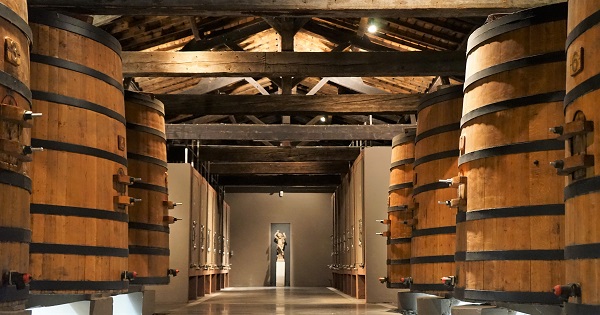Red Wine Vinification

Alcoholic Fermentation
The first fermentation called alcoholic starts above 16°C (60°F). Sugars are turned into alcohol while carbon dioxide and heat are released.
Alcoholic fermentation usually takes place in vats (steel or cement) where it is easy to control both temperature and speed of fermenation. An error at this stage can result in wine faults.
The pomace (skin+pips) is then pressed and mixed with the fermented must. Now can the second fermentation (malolactic) start.
"Whole Cluster " fermentation means that stems and seeds are kept in contact with skins during alcoholic fermentation. Stems are naturally rich in tannins and the wine will reflect green, herbaceous and vegetal notes (unripe, green stems) or spicy, peppery, tobacco, black tea, forest floor notes (brown and woody stems). Whole cluster fermentation is the ancient practice and can be used with any red grape variety, but it's more common with Pinot Noir (thin skin), Syrah, Gamay and Grenache (GSM wines). Burgundy region and Pinot Noir grape are historically linked to this technique.
Destemming means to remove the stems from the grape bunches before fermenation.
Carbonic Maceration is a winemaking technique where the grapes are not crushed and alcoholic fermentation starts inside the berries. A sealed vat is filled with carbon dioxide.
Malolactic Fermentation (MLF)
Malolactic bacteria consume malic acid (naturally present in the grape) and convert it to lactic acid. MLF is essentially the conversion of malic acid into lactic acid. As a result the wines become rounder, fuller and less acidic. Practically easier to drink and to match with food.
Barrel Fermentation
After the two fermentations are completed, the wine is separeted from its lees (dead yeast cells) and sulfites are added to protect against oxydation. Now it´s time to sleep! Barrel fermentation, storage, and aging will cause the wine to absorb taste from the wood, like vanilla, caramel, spices, smoke and toast flavors.
Fermentation
Alcoholic Fermentation is sugar + yeast transformed into alcohol + CO2.
The brewing and baking yeast Saccharomyces cerevisiae, ferments grape juice (must) into wine.
The main difference between white and red wines is that white grapes are first pressed and so fermented. Red grapes are first fermented, so placed in vats to macerate and finally pressed.
After alcoholic fermentation you can choose to start a secondary fermentation called Malolactic where Malic Acid is converted into Lactic Acid by Oenococcs Oeni bacteria.
Aging (Élevage)
Sulphiting (to add sulphur) protects the wine by preventing microbial growth. Sulphur is added before the long rest (several months) called maturing or aging (Élevage). Since sulfites form naturally during fermentation, nearly all wines contain low levels of them even when not added up or sprayed in the fields.
Aging in steel or oak barrels? How long? How much to manipulate it? Wine can be stored in oak barrels between 8-24 months. This period depends on the vintage and style of wine. Exchange of aromas from the oak barrels and oxigen (micro-oxigenation) takes place. The portion of spirit lost to evaporation is called Angel's Share and barrels must be topped off regularly.
Crushing vs Pressing
Grape clusters are first sorted (Triage) for quality (unripe, diseased, damaged grapes, leaves, bugs), then destemmed, crushed, and pressed.
Crushing (Foulage) means to break open the skins by gentle pressure so the pulp (juice) gets access to yeast, tannins and broken skins. These solids provide body, color and flavor to the juice. Crushing is used to make red or rosé wines. Modern destemmer/crushing machines are calibrated to not to crush the seeds which are full of bitter tannins.
Crushing is different from Pressing (Pressurage) where the grapes, clusters and pomace are pressed to extract the juice (no skin or tannin contact). Pressing is used to make white wine (no skin contact). Pressing in red wine production happens after the alcoholic fermentation.
Bottling (Packaging)
750 ml glass bottles are the most used form for wine packaging.
Why 750ml standard volume? Probably because it is the human pulmonary capacity (exhalation volume). Bottles used to be made by glass blowing. 750 ml is also the exact quantity of wine per 6 serving glasses x 125 ml each.
Form: Bordeaux bottle is the most popular in the world. You recognize the distinctive "high shoulders". The typical varietals are Cabernet Sauvignon, Merlot and Sauvignon Blanc. Burgundy bottle has sloping shoulders. Easier to produce. The typical varietals are Pinot Noir and Chardonnay. Alsace/Germanic bottle is tall and slender and associated with Riesling or Gewürztraminer. Champagne bottles are thicker to withstand the inner pressure.
Color: dark green or brown glass for red wines- darker colors provide sun light protection. Light exposure makes wine age rapidly. Light green or clear glass is used for white wines that are consumed younger and stored in a refrigerator (dark). Rosé wines bottles love clear glass to showcase their attractive color.
Dimension:
18l Solomon = 24 standard
15l Nebuchadnezzar = 20 standard
12l Balthazar = 16 standard
9l Salmanazar = 12 standard
6l Impériale = 8 standard
4,5l Jéroboam = 6 standard
3l Double Magnum = 4 standard
1,5l Magnum = 2 standard
75cl Standard
37,5cl Half or Demi = half a standard
18,7cl Piccolo or Split = single serving